ASRock FM2A88X Extreme6+ Review
by Ian Cutress on March 19, 2014 11:59 AM ESTSystem Benchmarks
Rightmark Audio Analyzer 6.2.5
The premise behind Rightmark:AA is to test the input and output of the audio system to determine noise levels, range, harmonic distortion, stereo crosstalk and so forth. Rightmark:AA should indicate how well the sound system is built and isolated from electrical interference (either internally or externally). For this test we connect the Line Out to the Line In using a short six inch 3.5mm to 3.5mm high-quality jack, turn the OS speaker volume to 100%, and run the Rightmark default test suite at 192 kHz, 24-bit. The OS is tuned to 192 kHz/24-bit input and output, and the Line-In volume is adjusted until we have the best RMAA value in the mini-pretest. We look specifically at the Dynamic Range of the audio codec used on board, as well as the Total Harmonic Distortion + Noise.
Dynamic Range for the ASRock FM2A88X Extreme6+
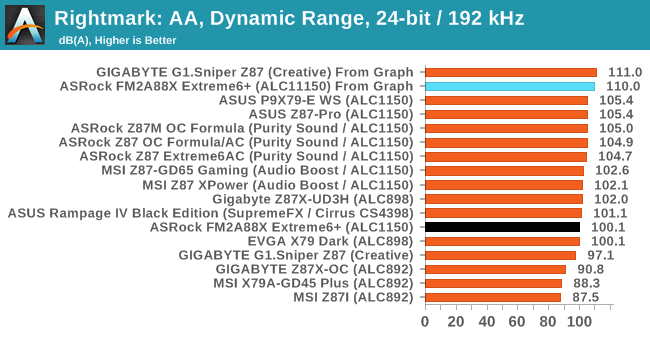
Despite the Realtek ALC1150 having a 115dB signal-to-noise rating, our RMAA test gave a result nearer 100. Within the 20 Hz – 20 kHz range of our SNR test, we see harmonic spikes at 100 Hz, 200 Hz and 300 Hz around 110 dB, making that our hearing range read-off value.
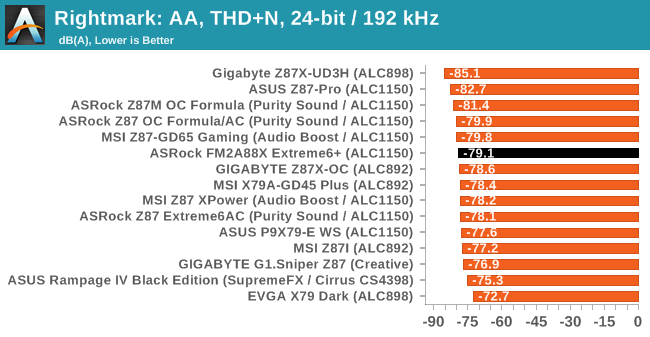
USB Backup
For this benchmark, we run CrystalDiskMark to determine the ideal sequential read and write speeds for the USB port using our 240 GB OCZ Vertex3 SSD with a SATA 6 Gbps to USB 3.0 converter. Then we transfer a set size of files from the SSD to the USB drive using DiskBench, which monitors the time taken to transfer. The files transferred are a 1.52 GB set of 2867 files across 320 folders – 95% of these files are small typical website files, and the rest (90% of the size) are the videos used in the WinRAR test. In an update to pre-Z87 testing, we also run MaxCPU to load up one of the threads during the test which improves general performance up to 15% by causing all the internal pathways to run at full speed.
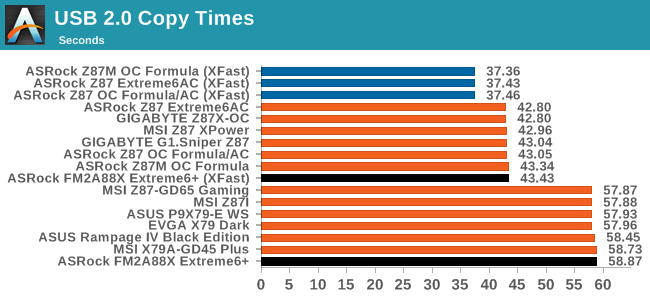
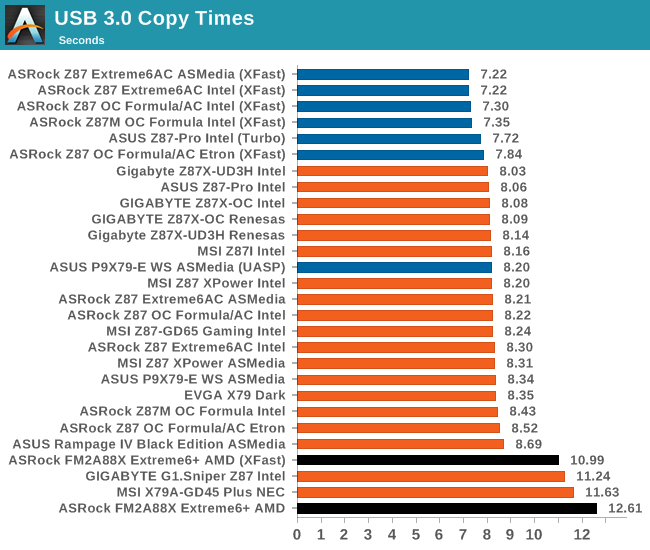
ASRock is still using its XFast software, which in our Windows 7 testing causes a significant shift in USB 2.0 performance. USB 3.0 also gets a ~13% speed-up.
DPC Latency
Deferred Procedure Call latency is a way in which Windows handles interrupt servicing. In order to wait for a processor to acknowledge the request, the system will queue all interrupt requests by priority. Critical interrupts will be handled as soon as possible, whereas lesser priority requests, such as audio, will be further down the line. So if the audio device requires data, it will have to wait until the request is processed before the buffer is filled. If the device drivers of higher priority components in a system are poorly implemented, this can cause delays in request scheduling and process time, resulting in an empty audio buffer – this leads to characteristic audible pauses, pops and clicks. Having a bigger buffer and correctly implemented system drivers obviously helps in this regard. The DPC latency checker measures how much time is processing DPCs from driver invocation – the lower the value will result in better audio transfer at smaller buffer sizes. Results are measured in microseconds and taken as the peak latency while cycling through a series of short HD videos - less than 500 microseconds usually gets the green light, but the lower the better.
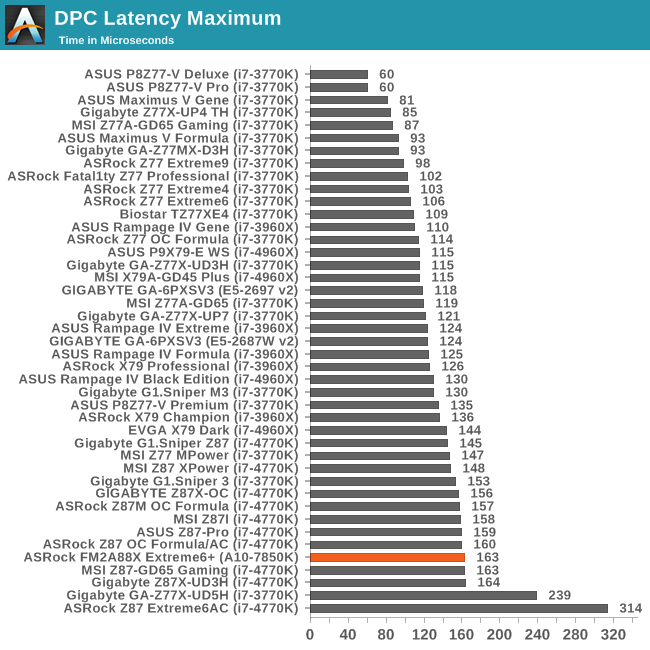
The A88X platform kicks off with a ~160 microsecond result in our DPC test, strangely matching most of our Intel 8-series results. We have another A88X motherboard in to test which also gets around the same result, suggesting that for lower peak DPC values, older platforms provide better results.











44 Comments
View All Comments
niva - Wednesday, March 19, 2014 - link
These benchmarks are making me depressed for AMD CPUs. I guess it's time to switch to Intel after not having purchased an Intel chip since 1996.nathanddrews - Wednesday, March 19, 2014 - link
Come on in, the water's fine.Malorcus - Wednesday, March 19, 2014 - link
I hear you man, I did the same with my current Ive Bridge CPU. I am looking to build a media computer using an AMD APU though. They still have their niche, but it is not in high end computing/gaming.ddriver - Wednesday, March 19, 2014 - link
You'd be surprised by the amount of needed and commercially viable tasks for which those poor CPUs are more than fast enough. It is a sad thing to see AMD struggling to compete with Intel's value products.Fallen Kell - Thursday, March 20, 2014 - link
AMD has sadly not had a real competing product in the high end side for 6 or 7 years now. On the low end, AMD was competing, until Intel decided to compete in this market segment. The last two updates that Intel has made were more focused on the lower end than on the high end. This is finally cutting into the one thing keeping AMD alive. I really hope AMD does survive because those of us that are old enough to remember know that Intel hates the consumer and only really pushes technology when it is competing. We would have CPU's that are only soldered directly into motherboards with no ability to upgrade, completely locked down CPUs with no ability to overclock, locked in memory bus speeds that are tiered based on the CPU/motherboard that you purchased with higher performance memory compatibility costing you extra, etc., etc....But I really don't see a way that AMD can compete at this point. They are still hemorrhaging money (not nearly as bad as a year ago when they lost $1.2 BILLION, but even after restructuring to cut 31% of their operating costs, they still lost $162 million last year). While I understood the reason for acquiring ATI, I believe ATI is worse off due to that acquisition. ATI went from being a profitable company competing well in their market, to one that is losing money and is seemingly almost a generation behind Nvidia in their offerings (I say this based on the fact that the brand new released top of the line AMD graphics cards can barely beat the last generation of cards from Nvidia in performance and can not come anywhere near the Nvidia offerings in power/performance or heat/performance, and Nvidia is getting ready to release its true next generation of cards even while they simply released the last generation of cards at their full potential to beat AMD's current cards now that AMD finally had a competing product). The major losses that AMD as a whole has, is taking its toll on the R&D AMD can afford to do in terms of increasing the efficiency of their designed with respect to power and cooling requirements while still being able to push the performance of their cards.
Demiurge - Friday, March 21, 2014 - link
Funny, I thought the same thing about Intel CPU's when GPU's started to encroach on the high performance features such as physics, ray-tracing, signal processing, and other high intensity applications. There's a bigger picture that I think a lot of people miss. The market has already shifted away from CPU's being the centerpiece of high performance applications. AMD has the right strategy with buying ATI and the paradigm of Heterogeneous Computing, but like Intel with the P4: it's too little too late. If they had the software, they might've been able to pull this off, but that is exactly what they are trying to do with Mantle. I think only unanimous adoption would've guaranteed a win. It was a big risk, and it would have been an amazing upstart, but I don't think it will pay off as much as they need it to. Just a modest opinion... and so a long rant ends... ;-)pandemonium - Thursday, March 20, 2014 - link
AMD hasn't been competitive to Intel for the consumer since 1999 or so? They've always been cheaper, and always been far lower in gaming and general desktop usage results as well. You are very, very, very late to the party, lol.mr_tawan - Thursday, March 20, 2014 - link
I believe it was Intel Core series (2006) that started to get ahead of AMD's CPU. Before that, AMD CPUs was both perform better and cheaper. Intel CPUs were power hungry and expensive while did not yield excellent performance.The raw ALU performance on the current line of AMD CPU is quite low because of the design decision to reduce the space occupied by the CPU while add even more GPU on the die, and then make them work together more nicely. It's the direction the AMD heads to.
I believe that one day even the FX line would be APU just like those A-series.
Vinny DePaul - Thursday, March 20, 2014 - link
I feel your pain. I am an AMD fan. I want to keep using AMD but the CPU is running too hot. It is heating up the room! I switch to Intel. It is just easier.... I hope the AMD's involvement in PS4 and Xbox One will shape the future in games and software.Xpl1c1t - Thursday, March 20, 2014 - link
This is exactly what I did going from a Athlon XP Palomino, to Athlon 64 Venice, to a Core i5 Lynnfield.I'd consider purchasing an AMD processor again if the whole APU thing becomes quite competent and powerful at a smaller and more efficient node. I'd promptly and gladly buy an APU with the equivalent of 2 IVB cores and a 7870 onboard if it could me mounted on a Pico-ITX board...